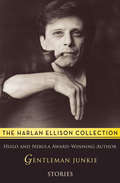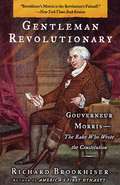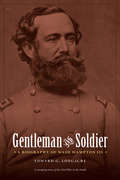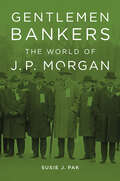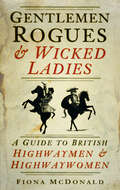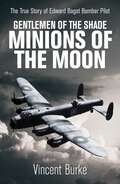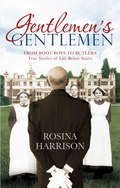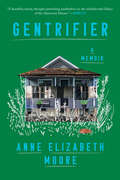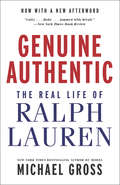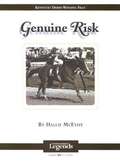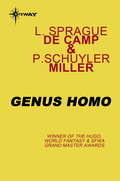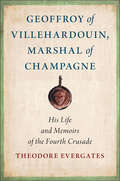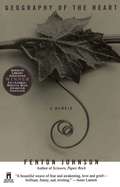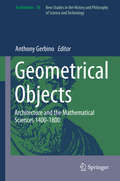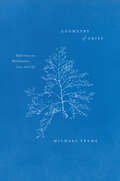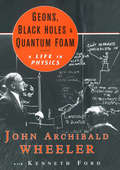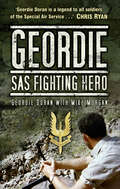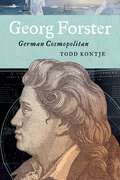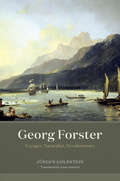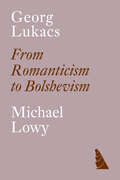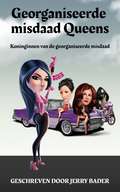- Table View
- List View
Gentleman Junkie: Stories
by Harlan EllisonBold and uncompromising, Gentleman Junkie and Other Stories of the Hung-up Generation is a watershed moment in Harlan Ellison's early writing career. Rather than dealing in speculative fiction, these twenty-five short stories directly tackle issues of discrimination, injustice, bigotry, and oppression by the police. Pulling from his own experience, Ellison paints vivid portraits of the helpless and downtrodden, blazing forth with the kind of unblinking honesty that would define his career. Reviewing this collection, Dorothy Parker called Ellison "a good, honest, clean writer, putting down what he has seen and known, and no sensationalism about it."
Gentleman Overboard
by Herbert Clyde LewisGentleman Overboard, first published in 1937, is a novella about a man (a Wall Street banker) who accidentally slips overboard while on a freighter-cruise ship bound from Honolulu to Panama City. The book moves back and forth between the thoughts of the man in the water as he comes to terms with his inevitable fate, and that of the ship's crew and fellow passengers, who search first the ship, then the sea. Gentleman Overboard was the first novel of author Herbert Clyde Lewis (1909-1950) who would go on to write three additional books. Lewis began his career as a journalist in China and New York City, followed by a time writing screenplays in Hollywood.
Gentleman Revolutionary: Gouverneur Morris, the Rake Who Wrote the Constitution
by Richard BrookhiserThe author of several books on the US founding fathers portrays the politics and pleasure-loving life of the rarely credited draftsman of the Constitution's final form and author of its "We the people" preamble, during the American and French Revolutions. Annotation ©2004 Book News, Inc., Portland, OR (booknews.com)
Gentleman and Soldier: A Biography of Wade Hampton III
by Edward G. LongacreWinner of the Douglas Southall Freeman History Award, Gentleman and Soldier is the first biography in more than fifty years of Wade Hampton III (1818–1902), a Confederate general whose life provides a unique, sweeping insight into the entire history of the Civil War in the South. Hampton was a leading citizen of South Carolina before the war and the highest-ranking cavalry leader on either side during the war. He fought in a remarkable number of battles from Antietam to Gettysburg to Bentonville and after the war served as governor of South Carolina and in the U.S. Senate.Hampton’s life, however, was one of dramatic contradictions. He was the quintessential slave owner who nonetheless questioned the ethical underpinnings of the “peculiar institution.” He was a prewar spokesperson for national unity but became an avid secessionist. He condemned violence and abhorred dueling, but he probably killed more opponents in battle than any other general with the possible exception of Nathan Bedford Forrest. He “redeemed” South Carolina from Reconstruction but then extended more political benefits to African Americans than any other Democratic governor in the postwar South. For more than forty years he gave selflessly of himself to his state and his community, not only when wealthy but also when teetering on the abyss of poverty.
Gentlemen Bankers: The World of J. P. Morgan (Harvard Studies in Business History #51)
by Susie J. PakThis account of the Morgan family’s social and economic circles and Wall Street’s unspoken rules “greatly enriches our understanding of the entire era.” —The Wall Street JournalGentlemen Bankers investigates the social and economic circles of one of America’s most renowned and influential financiers to uncover how the Morgan family’s power and prestige stemmed from its unique position within a network of local and international relationships.At the turn of the twentieth century, private banking was a personal enterprise in which business relationships were a statement of identity and reputation. In an era when ethnic and religious differences were pronounced and anti-Semitism was prevalent, Anglo-American and German-Jewish elite bankers lived in their respective cordoned communities, seldom interacting with one another outside the business realm. Ironically, the tacit agreement to maintain separate social spheres made it easier to cooperate in purely financial matters on Wall Street. But as Susie Pak demonstrates, the Morgans’ exceptional relationship with the German-Jewish investment bank Kuhn, Loeb & Co., their strongest competitor and also an important collaborator, was entangled in ways that went far beyond the pursuit of mutual profitability.Delving into the archives of many Morgan partners and legacies, Gentlemen Bankers draws on never-before published letters and testimony to tell a closely focused story of how economic and political interests intersected with personal rivalries and friendships among the Wall Street aristocracy during the first half of the twentieth century.
Gentlemen Rogues and Wicked Ladies: A Guide to British Highwaymen and Highwaywomen
by Fiona McDonaldEveryone loves a romantic rogue whose exciting exploits feature a cheeky disregard for the law, narrow escapes and lots of love interest. Even at the height of highway robbery activity in the eighteenth century, it was thought that the death penalty was too harsh for these wayward scoundrels. There was the ever-courteous Claude Duval, the epitome of gentlemanliness; the infamous Katherine Ferrers, who was the inspiration for the film The Wicked Lady; Dick Turpin, the most famous highwayman of them all; and lesser-known characters such as Tom Rowland, who dressed as a woman to avoid capture. All these and more form an entertaining volume that follows the mounted thief in their endless match against the law and a death by public hanging.
Gentlemen of the Shade - Minions of the Moon: The True Story of Edward Bagot Bomber Pilot
by Vincent Burke"From the skies over war-torn Europe to the opulent halls of English nobility, Edward Bagot's journey is a riveting testament to courage, heritage, and unwavering faith."Edward Bagot&’s memoir offers a unique personal perspective on World War II, combining his experiences as a Pathfinder pilot with his aristocratic heritage and deep religious convictions. Edward joined the Royal Australian Air Force (RAAF) during the latter part of the Second World War. He became a member of Bomber Command and a Pathfinder pilot. Intensely religious, Edward, who believed he had a premonition of his death, flew without fear, his faith sustaining him throughout his wartime experiences. His story is meticulously drawn from his diary, which he began at the age of fifteen, and the letters he sent to his family from England. Edward's wartime experiences, while reflective of many young Australians of his time, stand out due to his unique personal background and story. His heritage traced back to an aristocratic English family from the era of William the Conqueror, allowing him to spend his leave visiting his ancestral home and engaging in a remarkable social life among nobility and theatre celebrities in London's West End. Set against the relentless march toward war in Europe, Edward's narrative is one of patriotism and bravery. His personal accounts offer a unique perspective on the devastating yet transformative impact of the war, showcasing the fearlessness of young men like him who played crucial roles in shaping history.
Gentlemen's Disagreement: Alfred Kinsey, Lewis Terman, and the Sexual Politics of Smart Men
by Peter HegartyWhat is the relationship between intelligence and sex? In recent decades, studies of the controversial histories of both intelligence testing and of human sexuality in the United States have been increasingly common--and hotly debated. But rarely have the intersections of these histories been examined. In Gentlemen's Disagreement, Peter Hegarty enters this historical debate by recalling the debate between Lewis Terman--the intellect who championed the testing of intelligence-- and pioneering sex researcher Alfred Kinsey, and shows how intelligence and sexuality have interacted in American psychology. Through a fluent discussion of intellectually gifted onanists, unhappily married men, queer geniuses, lonely frontiersmen, religious ascetics, and the two scholars themselves, Hegarty traces the origins of Terman's complaints about Kinsey's work to show how the intelligence testing movement was much more concerned with sexuality than we might remember. And, drawing on Foucault, Hegarty reconciles these legendary figures by showing how intelligence and sexuality in early American psychology and sexology were intertwined then and remain so to this day.
Gentlemen's Gentlemen: From Boot Boys to Butlers, True Stories of Life Below Stairs
by Rosina HarrisonYou've read tales of lady's maids and cooks, housekeepers and nannies, but now it's time to hear from the other side of life as a servant. From the lamp boy to the butler, here are the fascinating storis from the men below stairs. This treasure-trove of memories, collected together by Rosina Harrison, bestselling author of The Lady's Maid, includes the night the ill-fated Edward VIII came to dinner; the time Charlie Chaplin scandalised the servants with his 'familiar' behaviour - and the occasion when a hot potato dropped down a lady's décolletage at a veryexclusive supper party . . .
Gentrifier: A Memoir
by Anne Elizabeth MooreTaking on the thorny ethics of owning and selling property as a white woman in a majority Black city and a majority Bangladeshi neighborhood with both intelligence and humor, this memoir brings a new perspective to a Detroit that finds itself perpetually on the brink of revitalization.In 2016, a Detroit arts organization grants writer and artist Anne Elizabeth Moore a free house—a room of her own, à la Virginia Woolf—in Detroit&’s majority-Bangladeshi &“Banglatown.&” Accompanied by her cats, Moore moves to the bungalow in her new city where she gardens, befriends the neighborhood youth, and grows to intimately understand civic collapse and community solidarity. When the troubled history of her prize house comes to light, Moore finds her life destabilized by the aftershocks of the housing crisis and governmental corruption. This is also a memoir of art, gender, work, and survival. Moore writes into the gaps of Woolf&’s declaration that &“a woman must have money and a room of one&’s own if she is to write&”; what if this woman were queer and living with chronic illness, as Moore is, or a South Asian immigrant, like Moore&’s neighbors? And what if her primary coping mechanism was jokes? Part investigation, part comedy of a vexing city, and part love letter to girlhood, Gentrifier examines capitalism, property ownership, and whiteness, asking if we can ever really win when violence and profit are inextricably linked with victory.
Genuine Authentic: The Real Life of Ralph Lauren
by Michael GrossA fascinating and comprehensive look into the life of American fashion designer Ralph Lauren, now with an afterword.“Deep-dish...sharp-clawed...honestly admiring.”—New York TimesThere are at least two Ralph Laurens. To the public he's a gentle, modest, yet secure and purposeful man. Inside the walls of Polo Ralph Lauren, though, he was long seen by some as a narcissist, an insecure ditherer, and, at times, a rampaging tyrant. Michael Gross, author of the bestsellers Model and 740 Park, lays bare the truths of this fashion emperor's rise, and reveals not only the secrets of his meteoric success in marketing our shared fantasies, but also a widely unknown side that's behind the designer’s chic façade.
Genuine Risk (Thoroughbred Legends #20)
by Hallie McEvoyShe was a classic diva. Brassy, beautiful, and bold, Genuine Risk did things her way, from taking on the boys on the racetrack to making her owners, caretakers, and fans wait thirteen years before she had a baby. On May 3, 1980, Genuine Risk became the second filly ever to win the Kentucky Derby, and she did it with style, grabbing the lead with a quarter-mile to run and holding it to the finish. In the Preakness she endured a rough trip, including bumping and being hit with another jockey’s whip, only to come up short. A second in the Belmont Stakes gave her the best finish by a filly in all three Triple Crown races. In this newest Thoroughbred Legends volume, author Hallie McEvoy tells Genuine Risk’s compelling story, including the great expectations for her as a mother, the intense disappointment year after year when she failed to produce a foal, and the overwhelming joy when she finally gave birth to a colt named Genuine Reward.
Genus Homo
by L. Sprague deCamp P. Schuyler MillerTwenty-five men and women against a world of evolution gone mad!Here is the vivid story of their adventures and terrors - the monster in the forest - the city of giant beavers - and the secret of the incredible race that had supplanted mankind.
Geoffrey of Monmouth and the Feminist Origins of the Arthurian Legend
by Fiona TolhurstGeoffrey of Monmouth and the Feminist Origins of the Arthurian Legend provides the first feminist analysis of both the Arthurian section of The History of the Kings of Britain and The Life of Merlin. Fiona Tolhurst argues that because Geoffrey creates nontraditional and unusually powerful female figures, he stands outside of and works against the misogyny of the medieval literary tradition. This study employs the strategies of both historicist and New Historicist critics and adds a new dimension to existing scholarship by proposing that the word 'feminist' can be used to describe a medieval text that presents female figures meaningfully and, in most cases, positively. "
Geoffrey of Monmouth and the Translation of Female Kingship
by Fiona TolhurstGeoffrey of Monmouth and the Translation of Female Kingship provides the first feminist analysis of the part of The History of the Kings of Britain that most readers overlook: the reigns before and after Arthur's.
Geoffroy of Villehardouin, Marshal of Champagne: His Life and Memoirs of the Fourth Crusade (Medieval Societies, Religions, and Cultures)
by Theodore EvergatesGeoffroy of Villehardouin, Marshal of Champagne by Theodore Evergates traces the remarkable life of Geoffroy of Villehardouin (c. 1148–c. 1217) from his earliest years in Champagne through his last years in Greece after the crusade. The fourth son of a knight, Geoffroy became marshal of Champagne, principal negotiator in organizing the Fourth Crusade, chief of staff of the expedition to and conquest of Constantinople, garrison commander of Constantinople and, in his late fifties, field commander defending the Latin settlement in the Byzantine empire against invading Bulgarian armies and revolting Greek cities. Known for his diplomatic skills and rectitude, he served as the chief military advisor to Count Thibaut III of Champagne and later to Emperor Henry of Constantinople.Geoffroy is remarkable as well for dictating the earliest war memoir in medieval Europe, which is also the earliest prose narrative in Old French. Addressed to a home audience in Champagne, he described what he did, what he saw, and what he heard during his eight years on crusade and especially during the fraught period after the conquest of Constantinople. His memoir, The Book of the Conquest of Constantinople, furnishes a commander's retrospective account of the main events and inner workings of the crusade—the innumerable meetings and speeches, the conduct (not always commendable) of the barons, and the persistent discontent within the army—as well as a celebration of his own deeds as a diplomat and a military commander.
Geography of the Heart
by Fenton JohnsonIn 1990, Larry Rose, the partner of novelist Fenton Johnson, died of complications from AIDS. In Geography of the Heart, Fenton, author of Scissors, Paper, Rock, Songs of the Soil, and Crossing the River, honors Rose with a beautifully written memoir.
Geometrical Objects
by Anthony GerbinoThis volume explores the mathematical character of architectural practice in diverse pre- and early modern contexts It takes an explicitly interdisciplinary approach, which unites scholarship in early modern architecture with recent work in the history of science, in particular, on the role of practice in the "scientific revolution" As a contribution to architectural history, the volume contextualizes design and construction in terms of contemporary mathematical knowledge, attendant forms of mathematical practice, and relevant social distinctions between the mathematical professions As a contribution to the history of science, the volume presents a series of micro-historical studies that highlight issues of process, materiality, and knowledge production in specific, situated, practical contexts Our approach sees the designer's studio, the stone-yard, the drawing floor, and construction site not merely as places where the architectural object takes shape, but where mathematical knowledge itself is deployed, exchanged, and amplified among various participants in the building process.
Geometry of Grief: Reflections on Mathematics, Loss, and Life
by Michael FrameIn this profound and hopeful book, a mathematician and celebrated teacher shows how mathematics may help all of us—even the math-averse—to understand and cope with grief. We all know the euphoria of intellectual epiphany—the thrill of sudden understanding. But coupled with that excitement is a sense of loss: a moment of epiphany can never be repeated. In Geometry of Grief, mathematician Michael Frame draws on a career’s worth of insight—including his work with a pioneer of fractal geometry Benoit Mandelbrot—and a gift for rendering the complex accessible as he delves into this twinning of understanding and loss. Grief, Frame reveals, can be a moment of possibility. Frame investigates grief as a response to an irrevocable change in circumstance. This reframing allows us to see parallels between the loss of a loved one or a career and the loss of the elation of first understanding a tricky concept. From this foundation, Frame builds a geometric model of mental states. An object that is fractal, for example, has symmetry of magnification: magnify a picture of a mountain or a fern leaf—both fractal—and we see echoes of the original shape. Similarly, nested inside great loss are smaller losses. By manipulating this geometry, Frame shows us, we may be able to redirect our thinking in ways that help reduce our pain. Small-scale losses, in essence, provide laboratories to learn how to meet large-scale losses. Interweaving original illustrations, clear introductions to advanced topics in geometry, and wisdom gleaned from his own experience with illness and others’ remarkable responses to devastating loss, Frame’s poetic book is a journey through the beautiful complexities of mathematics and life. With both human sympathy and geometrical elegance, it helps us to see how a geometry of grief can open a pathway for bold action.
Geons, Black Holes, and Quantum Foam: A Life in Physics
by Kenneth Ford John Archibald WheelerThe autobiography of one of the preeminent figures in twentieth-century physics. He studied with Niels Bohr, taught Richard Feynman, and boned up on relativity with his friend and colleague Albert Einstein. John Archibald Wheeler's fascinating life brings us face to face with the central characters and discoveries of modern physics. He was the first American to learn of the discovery of nuclear fission, later coined the term "black hole," led a renaissance in gravitation physics, and helped to build Princeton University into a mecca for physicists. From nuclear physics, to quantum theory, to relativity and gravitation, Wheeler's work has set the trajectory of research for half a century. His career has brought him into contact with the most brilliant minds of his field; Fermi, Bethe, Rabi, Teller, Oppenheimer, and Wigner are among those he called colleagues and friends. In this rich autobiography, Wheeler reveals in fascinating detail the excitement of each discovery, the character of each colleague, and the underlying passion for knowledge that drives him still.
Geordie: SAS Fighting Hero
by Mike Morgan Geordie DoranGeordie Doran ranks as one of the most remarkable fighting soldiers of the twentieth century. Growing up in Jarrow during the Depression years of the 1930s, Geordie signed up as a private soldier in 1946 and embarked on a career spanning 40 years. He saw active service in Germany, Cyprus, the Korean War and Suez; he became an expert in jungle warfare in Malaya and in Borneo, as well as on key special operations in the deserts of Oman and Yemen, and Colonel Gaddafi’s Libya. After returning to England in the early 1970s, a serious road accident curtailed his frontline soldiering career; however, he found a new and vital role as a permanent staff instructor with 23 SAS (TA) training the cream of recruits. He left the SAS in 1972, but could not settle into civilian life and found himself a job as a storeman in the SAS Quartermaster’s stores – a job which lasted another 12 years, during which time he equipped many famous SAS characters for their famous clandestine missions.
Georg Forster: German Cosmopolitan (Max Kade Research Institute)
by Todd KontjeGeorg Forster (1754–1794) was famous during his lifetime, notorious after his death, and largely forgotten by the later nineteenth century. Remembered today as the young man who sailed around the world with Captain Cook and as one of the leading figures in the revolutionary Republic of Mainz, Forster was also a prolific writer and translator who left behind two travelogues, a series of essays on diverse topics, and numerous letters. This in-depth look at Forster’s work and life reveals his importance for other writers of the age. Todd Kontje traces the major intellectual themes and challenges found in Forster’s writings, interweaving close textual analysis with his rich but short life. Each chapter engages with themes that reflect the current debates in eighteenth-century literary and cultural studies, including changing notions of authorship, multilingualism, the representation of so-called primitive societies, Enlightenment ideas about race, and early forms of ecological thinking. As Kontje shows, Forster’s peripatetic life, malleable sense of national identity, and fluency in multiple languages contrast with the image of the solitary genius in the “age of Goethe.” In this way, Forster provides a different model of authorship and citizenship better understood in the context of an increasingly globalized world.Compellingly argued and engagingly written, this book restores Forster to his rightful place within the German literary tradition, and in so doing, it urges us to reconsider the age of Goethe as multilingual and malleable, local and cosmopolitan, dynamic and decentered. It will be welcomed by specialists in German studies and the Enlightenment.
Georg Forster: Voyager, Naturalist, Revolutionary
by Jürgen Goldstein“Marvelous. . . . Wonderfully imaginative. . . . Sparkling.”—Wall Street Journal “Stunning. . . . Read this book: in equal measure it will give you hope and trouble your dreams.”—Laura Dassow Walls, author of Henry David Thoreau: A Life and Passage to Cosmos: Alexander von Humboldt’s Shaping of America Georg Forster (1754–94) was in many ways self-taught and rarely had two cents to rub together, but he became one of the most dynamic figures of the Enlightenment: a brilliant writer, naturalist, explorer, illustrator, translator—and a revolutionary. Granted the extraordinary opportunity to sail around the world as part of Captain James Cook’s fabled crew, Forster touched icebergs, walked the beaches of Tahiti, visited far-flung foreign nations, lived with purported cannibals, and crossed oceans and the equator. Forster recounted the journey in his 1777 book A Voyage Round the World, a work of travel and science that not only established Forster as one of the most accomplished stylists of the time—and led some to credit him as the inventor of the literary travel narrative—but also influenced other German trailblazers of scientific and literary writing, most notably Alexander von Humboldt. A superb essayist, Forster made lasting contributions to our scientific—and especially botanical and ornithological—knowledge of the South Seas. Having witnessed more egalitarian societies in the southern hemisphere, Forster returned after more than three years at sea to a monarchist Europe entering the era of revolution. When, following the French Revolution of 1789, French forces occupied the German city of Mainz, Forster became a leading political actor in the founding of the Republic of Mainz—the first democratic state on German soil. In an age of Kantian reason, Forster privileged experience. He claimed a deep connection between nature and reason, nature and politics, nature and revolution. His politics was radical in its understanding of revolution as a natural phenomenon, and in this often overlooked way his many facets—as voyager, naturalist, and revolutionary—were intertwined. Yet, in the constellation of the Enlightenment’s trailblazing naturalists, scientists, political thinkers, and writers, Forster’s star remains relatively dim today: the Republic of Mainz was crushed, and Forster died in exile in Paris. This book is the source of illumination that Forster’s journey so greatly deserves. Tracing the arc of this unheralded polymath’s short life, Georg Forster explores both his contributions to literature and science and the enduring relationship between nature and politics that threaded through his extraordinary four decades.
Georg Lukacs: From Romanticism to Bolshevism
by Michael LöwyOn the 100th anniversary of the publication of History and Class Consciousness, a new edition of this indispensable guide to Lukacs's thought and politicsThe philosophical and political development that converted Georg Lukács from a distinguished representative of Central European aesthetic vitalism into a major Marxist theorist and Communist militant has long remained an enigma.In this this now classic study, Michael Löwy for the first time traced and explained the extraordinary mutation that occurred in Lukács's thought between 1909 and 1929. Utilizing many as yet unpublished sources, Löwy meticulously reconstructed the complex itinerary of Lukács's thinking as he gradually moved towards his decisive encounter with Bolshevism.The religious convictions of the early Lukács, the peculiar spell exercised on him and on Max Weber by Dostoyevskyan images of pre-revolutionary Russia, the nature of his friendships with Ernst Bloch and Thomas Mann, were amongst the discoveries of the book.Then, in a fascinating case-study in the sociology of ideas, Löwy showed how the same philosophical problematic of Lebensphilosophie dominated the intelligentsias of both Germany and Hungary in the pre-war period, yet how the different configurations of social forces in each country bent its political destiny into opposite directions. The famous works produced by Lukács during and after the Hungarian Commune—Tactics and Ethics, History and Class Consciousness and Lenin—were analysed and assessed. A concluding chapter discussed Lukács's eventual ambiguous settlement with Stalinism in the thirties, and its coda of renewed radicalism in the final years of his life.In this new edition, Löwy has added a substantial new introduction which reassess the nature of Lukacs's thought in the light of newly published texts and debates.
Georganiseerde misdaad Queens Koninginnen van de georganiseerde misdaad
by Jerry Bader Marlies PermanOrganized Crime Queens De geheime wereld van vrouwelijke gangsters Van de bizarre wereld van vrouwelijke Japanse motorbendes tot de historische opkomst en ondergang van de veertig olifanten in Londen, de geschiedenis van vrouwelijke georganiseerde misdaad is zowel fascinerend als vreemd. Dit zijn de verhalen, zowel waar als legendarisch van de vrouwelijke misdaadbazen die de vorm van vrouwelijke goedertierenheid hebben doorbroken. Dit is de geheime wereld van vrouwelijke gangsters. Beschikbaar: amazon.com/author/jerrybader
